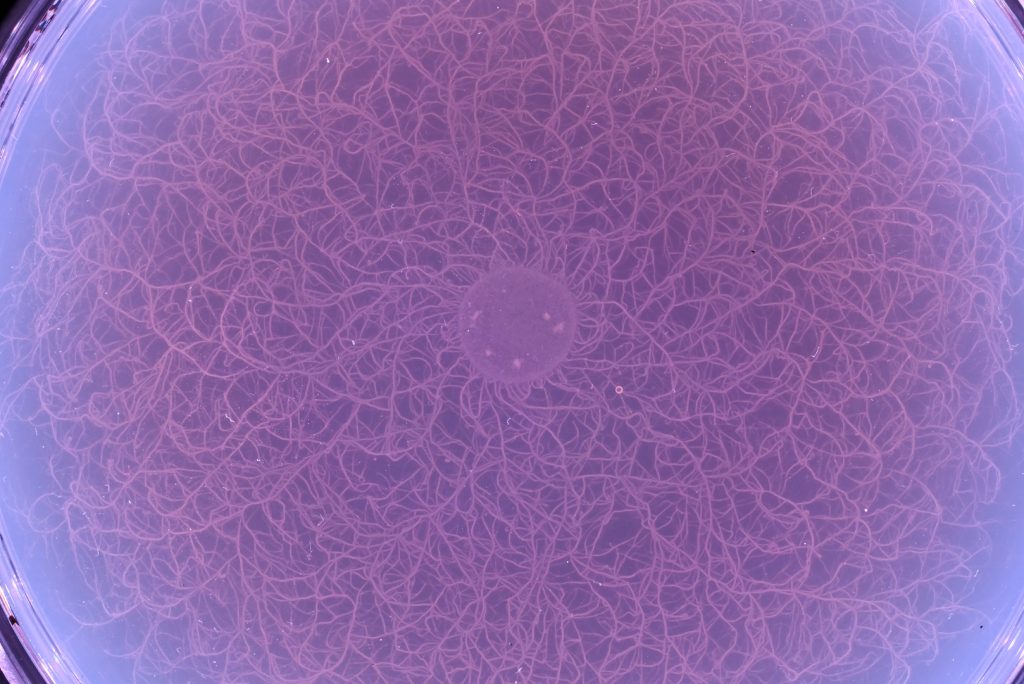phylum ( Carlos Castellanos, Johnny DiBlasi, Bello Bello )
[ United States ]
Invited Work
Beauty is a hybrid machine-microbial artwork, currently in development by [phylum] (Carlos Castellanos, Johnny DiBlasi, Bello Bello). The work features a bio-driven artificial intelligence system that remediates a contaminated soil ecology while generating an audio-visual composition in real-time. It creates a situation where the fates of the contaminated soil and a group of bacterial cultures are determined by the whims of an artificial intelligence learning agent with an internal model of “beauty”. The agent builds its model by observing the cooperative pattern-forming behaviors of Paenibacillus sp and other bacteria that exhibit collective social motility, producing intricate, branching growth patterns in response to environmental conditions. The agent then attempts to spatially modify the bacterial growth by introducing chemical attractants and repellents. Images of bacterial colony growth and movement are captured using time-lapse photography and analyzed by the agent to determine how well the colonies conform to its internal model of beauty. The more beautiful the growth patterns of the bacteria appear to the agent the more of a remediating solution the soil receives and the more nutrients the bacterial cultures receive. It is known, however, that these bacteria only produce their intricate patterns under environmental stressors such as lack of food and moisture. Thus, the agent also has to reduce nutrient levels and introduce stress-inducing chemicals into the bacterial cultures in order to properly remediate the contaminated soil. In essence, the bacteria may have to starve themselves in order to look beautiful for the agent. The agent will also express its “feelings” about this process via a series of evolving sound and visual patterns.
Part of larger investigations into the potential of combining non-human and computational intelligence in the development of culturally evocative digital media systems, Beauty is defined by a confluence of themes: ecology, microbial and machine agency and cultural notions of beauty and aesthetics. Foregrounding processes of renewal and emergence via a systems-based approach, Beauty addresses timely and relevant issues by establishing a unique interplay between “primitive” microorganisms, the aforementioned notions of beauty and aesthetic judgement, the status and implications of intelligent machines and the impact of humans (and their technologies) on our ecology. In addition, while today all manner of microorganic labor is marshaled to produce products for humanity ranging (not to mention their use in cleaning up our environmental messes), we recognize these creatures as lively and dynamic, with agency and lifeworlds of their own. Thus the motivation for this work lies in creating an interface or window through which these organisms can convey their complexity and otherness using a language that can be understood by humans and the intelligent systems they create, and in doing so, subtly questioning anthropocentric ontologies and ways of knowing.
- Medium: Pattern-forming bacteria, custom electronics, custom hardware, custom software
- Size: Variable
phylum
phylum is an experimental research collective specializing in cultural production informed by the intersections of science, technology and the arts. The members of [phylum] are Carlos Castellanos, Johnny DiBlasi and Bello Bello.
Carlos Castellanos
Rochester Institute of Technology
Carlos Castellanos (USA) is an interdisciplinary artist and researcher with a wide array of interests such as cybernetics, ecology, embodiment, phenomenology, artificial intelligence and transdisciplinary collaboration. His work bridges science, technology, education and the arts, developing a network of creative interaction with living systems, the natural environment and emerging technologies. His artworks have been exhibited at local, national and international events such the International Symposium of Electronic Art (ISEA), SIGGRAPH & ZERO1 San Jose. Castellanos is Assistant Professor in the School of Interactive Games and Media at Rochester Institute of Technology.
Carlos Castellanos’ website: ccastellanos.com
Johnny DiBlasi
Iowa State University
Johnny DiBlasi (USA) is a hybrid media artist who works with computational media, data, machine learning, and network hardware to create large-scale, interactive installations that fuse data into the physical architecture. He works at the intersection of art and science, and his work explores the aesthetic possibilities of biodata and how to connect users to the local ecosystem. DiBlasi is Assistant Professor of Scientific Visualization and Digital Media in the Department of Art and Visual Culture at Iowa State University. He earned an MFA from the Photographic and Electronic Media program at the Maryland Institute College of Art in Baltimore, MD. DiBlasi exhibits his artworks nationally and internationally.
Johnny DiBlasi’s website: http://johnnydiblasi.com/
Bello Bello
Bello Bello (USA) is an interdisciplinary artist whose focus is experimenting with art, biology, sound and technology. He creates custom electronics and software to enable participants to interact with plants and other lifeforms. Bello uses art and science as a means to showcase the beautiful and necessary symbiosis of earth’s diverse lifeforms, and his works utilize nature’s phenomenal energies as a catalyst for self-discovery and awareness. Bello received his Bachelor of Fine Arts with a concentration in Digital/Experimental Media from Kansas State University. In 2018 he received Mark A. Chapman and Cheryl Mellenthin Fine Arts Scholarship and a residency with Parallel Studios as part of the 21st Century Community Learning Grant in New, Mexico, where he taught interactive art workshop to middle school students.













